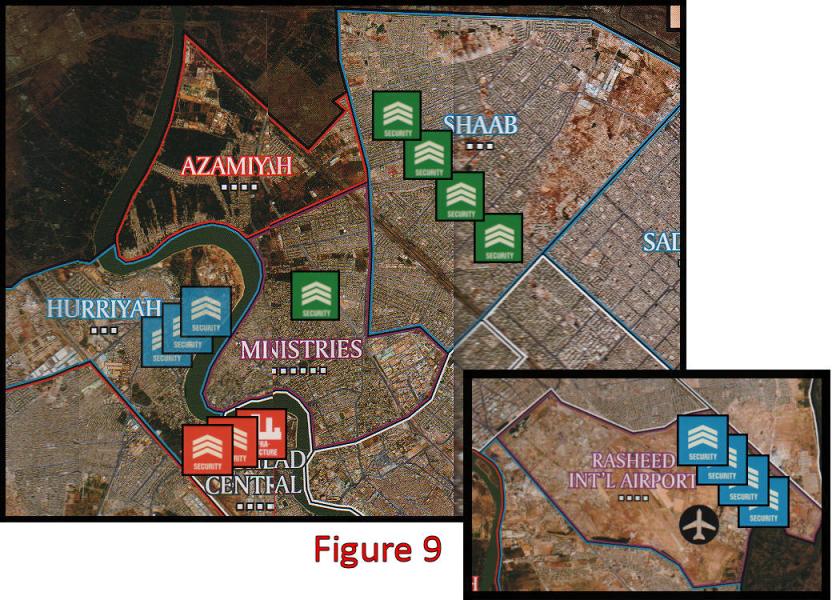Strange Bedfellows – Sunni/Shiite Cooperation in Battle for Baghdad
For both the Sunni and Shiite players in MCS Group’s Battle for Baghdad strategy board game, survival is a minute by minute struggle. Faced with an aggressive U.S. player, both had better be ready to bury the hatchet (somewhere other than in each other’s head) if they are to have a chance at victory. This article discusses a cooperative technique that can be employed by the Sunni and Shiite players, acting in concert, to inflict maximum irritation on the U.S. player while increasing their own chances of survival… and victory.

The Situation
Part of the Victory Condition requirements for both Sunni and Shiite players is to have at least one Infrastructure unit in an Iraqi National Government (ING) Affiliated Zone. With that in mind, let’s turn to our hypothetical situation. The US player has been wrestling with Al Qaeda in the southern areas of Baghdad and has therefore been unable (or unwilling) to respond to the considerable buildup of Shiite units in Shaab and Hurriyah zones. The Sunni and Shiite players have been having intense, secret discussions during the “Coalition” phase of each turn so, when the Sunni player moves into Baghdad Central, the US player assumes this to be part of an encircling move against the ING Ministries zone.
The ING currently has its hands full trying to maintain control of the Presidential Palace North zone, near Baghdad International Airport, and the Rasheed Int’l Airport zone in southeast Baghdad, both of which are still under ING control, but lightly defended. Seeing that the ING is in no position to withstand a coordinated Sunni/Shiite assault, the US and ING players have decided to allow the US to assume responsibility for defending the ING Ministries zone. Coordinated moves between the US and ING leave a strong US force controlling the Ministries zone, and the ING force has choppered back to the Presidential Palace North zone to avoid conflict with the US (remember that if the US and ING share a common zone at the start of the Combat Phase, they must fight).
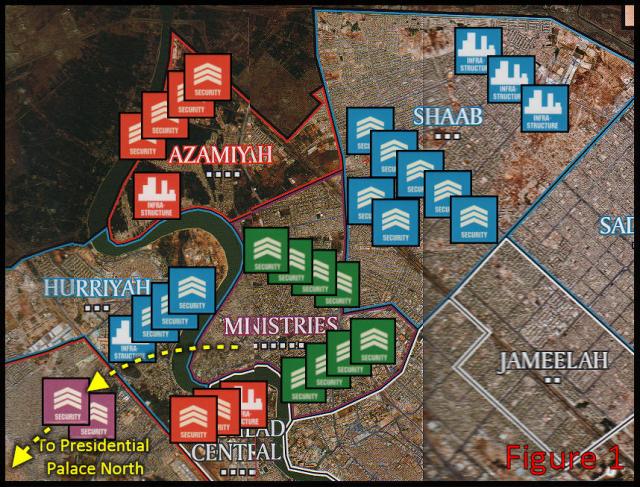
The next turn begins with forces arrayed as in Figure 1, above.
Required Conditions
Although I’m about to present a series of game actions that absolutely could take place in Battle for Baghdad, I want to point out that I’m only presenting one of an almost limitless range of possible sequences. I find this to be one of the most compelling and interesting aspects of the game. The sequence that I will present is only possible if the following three conditions are all true:
- The Sunni or Shiite player gains the Initiative, which will allow them to determine who moves first.
- The player seating order, going counter-clockwise, puts the US player after the Sunni, but before the Shiite.
- The Sunni player is in possession of either the Terror Spectacular card or the WMD Arms Bazaar card.
Once all the pieces are in place, the Sunni and Shiite players put the plan into action.
The Plan
The heart of the Sunni/Shiite cooperative plan is the agreement that they will not attack each other’s units, and that they will make a major push to clear ING zones of any US or Iraqi National Gov’t units, thereby clearing the way for one of them (or both of them) to soon be able to declare victory by occupying the required number of zones plus one ING zone.
During the Move Step of the Sunni Player’s Action Phase, he makes one move: a single Security unit moves directly into the American occupied Ministries Zone.
A single Sunni unit moving into the heavily defended Ministries Zone should immediately start setting off alarm bells in the American ranks (see Figure 3). They’ll immediately suspect the Sunni player is holding either the WMD or Terror Spectacular cards.
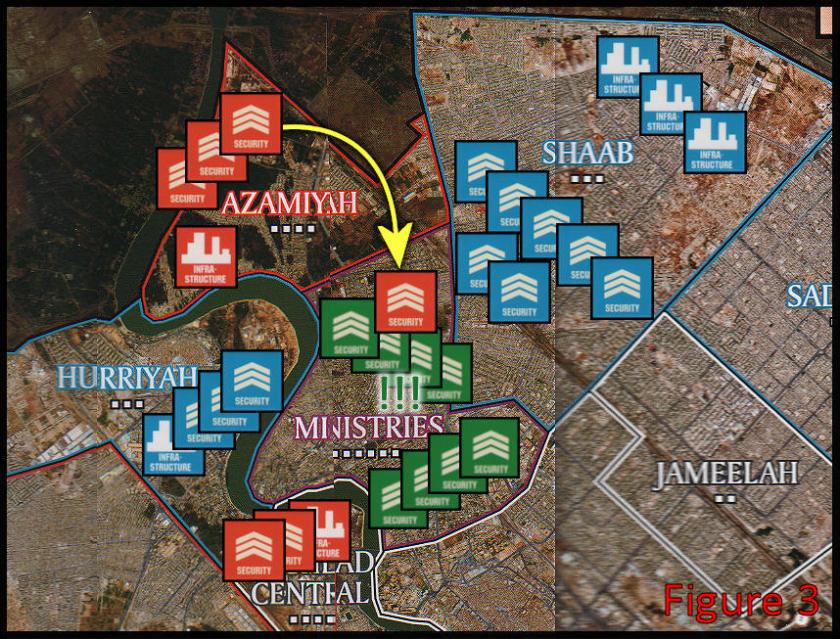
The objective is to either force the US units to abandon the Ministries Zone during their Move Step, or allow them to stand and die there. The American player may suspect that the Sunnis are bluffing, but that’s a hell of a chance to take. If they’re wrong (and we know they are), the end result will be the destruction of eight powerful US Security Units and a reward of 16 Political Points for the Sunnis (since destroying US Units nets the victor double the political points). Since the US player moves before the Shiite player, he’ll have no knowledge of what Shiite plans are.
The Shiite plan is to move his large force of Security units south to the ING Rashid Int’l Airport zone, thus providing a second simultaneous attack on the ING zones critical for victory to both Sunni and Shiite players. But this movement will not take place until after the US player moves. (see figure 4)
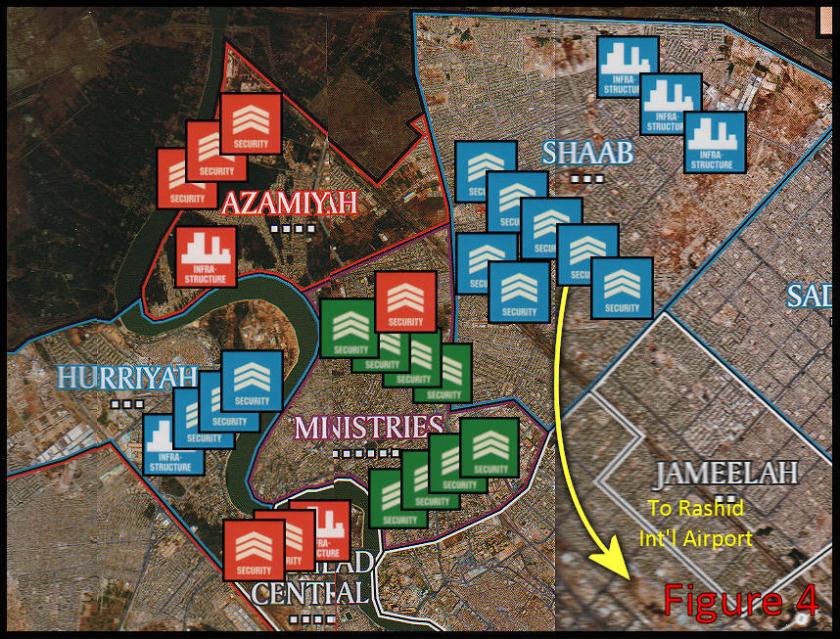
American Response
What are the US player’s options?
- A) Helicopter the hell out of there, possibly back to the Airport or Green Zone – At first glance, the safest option. But keep in mind that abandoning an ING zone to either the Shiite or Sunni player can cost him the game in short order. And what if, he wonders, the Sunni is bluffing and does not actually have the WMD or Terror Spectacular card? He’d feel awfully stupid getting bluffed out of a key position like that. On the positive side, with his US units out of the way, he gets to watch the Sunni/Shiite “allies” turn ugly and tear each other to pieces. (figure 5)

- B) Move aggressively into adjacent, enemy occupied zone – Determined to make the Sunni player pay in blood for the attack, the US player may choose to move into the Sunni affiliated Azamiyah zone. A wise US player will also leave one unit behind in the Ministries zone, so as to insure that the Sunni must play the WMD or Terror Spectacular card in order to guarantee the zone will be cleared of US units. Don’t want to just give that zone up without a fight! (figure 6)

- C) Call the bluff and sit tight in the zone – Hope that the Sunni is bluffing and does not actually possess the WMD or Terror Spectacular card. A bold move requiring nerves of steel… and the move the Sunni is desperately hoping for. (figure 7)
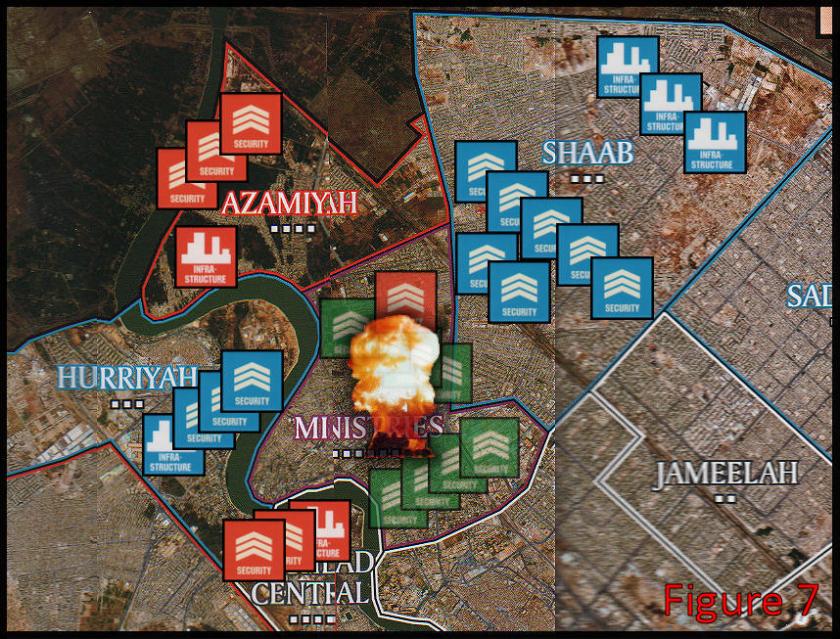
The Aftermath
If the US player chooses option “A”, the turn will most likely end with Sunnis and Shiites in control of two out of three Iraqi National Gov’t Affiliated Zones. If the Terror Spectacular/WMD card is actually played, the Shiites will control one ING zone and another will be completed vacated due to the major terrorist attack. Not a good outcome for any of the other players since it may put both Sunni and Shiite uncomfortably close to their victory conditions.
If option “C” is chosen, not only will the outcome be much the same as option “A” results, but the US will have sustained large casualties from the WMD or Terror Spectacular attack, filling Sunni coffers with Political Points to boot.
So, we’ll have to assume that the US player will choose option “B”. And let’s further assume a truly aggressive US player. He sends three Security units into Azamiyah to attempt to take out the Sunnis there. Four additional US Security units are sent into Shaab to punish the Shiites. And one US Security unit is left in Ministries so that the zone is not given up totally without a fight. (As a matter of fact, it will be quite difficult for the Sunni player to win this battle without use of the WMD card due to the fact that US Security units count double in combat and due to the superiority of the US Command Cards)
Following the US moves, the Shiite player decides to stick with the plan and moves all available Security units south to Rasheed Int’l Airport. (see figure 8 for final dispositions after movement)

Moving into the Combat Phase, let’s assume that the US player defeats the Shiite player handily in Shaab, and that the Shiite player is able to overwhelm the lightly defender Rasheed Int’l Airport zone and assume control there. I believe it would be best for the Sunni player to shift play of the WMD/Terror Spectacular card to Azimiyah, thereby eliminating 3 US units and, more importantly, picking up 6+ Political Points (2 each for the US Security Units destroyed + the value of the US Command Card played, if any). Even though all Sunni units are destroyed in the attack, the Political Point reward will more than pay for replacements.
At turn’s end, we find the US player still in control of the ING Ministries zone, having defeated the single Sunni unit there, and now in control of the Shiite affiliated Shaab zone. The Sunni affiliated Azamiyah zone has been completely cleared by the WMD/Terror Spectacular event. Finally, the Shiite player is now in control of the ING Rasheed Int’l Airport zone, after having lost 3 units fighting the ING defenders there.
On the surface it may appear that the US player is the big winner, since the US still has 5 units remaining of the original 8, while the Sunni player has lost 5 units and the Shiite player has lost 6 units.
The counterpoint can be made, however, that the US player was not in control this turn, but simply reacting to enemy actions. The turn ended with the Sunni player accumulating enough victory points to rebuild his losses and then some, and the Shiite player in control of a critical Victory requirement zone (Rasheed Int’l Airport). The following turn will once again find the US player simply reacting to events as he attempts to recapture Rasheed Int’l Airport and reinforce Ministries before someone else attacks the lightly defended zone.
Summary
It’s true that in Battle for Baghdad the US is not often defeated on the battlefield. But, as a North Vietnamese Colonel once said, it is also irrelevant. Cooperative play, not just between Sunni and Shiite, is essential to counter an aggressive US player.
The sequence of events described in this article is just one of a myriad of possibilities that may occur in an actual game. The turn might have proceeded in an entirely different direction if:
- The players were seated in a different order.
- The Sunni player did not draw the critical WMD or Terror Spectacular card.
- The US player withdrew from Ministries to Rasheed Int’l Airport, thereby denying that zone as a target for the Shiite player.
- The Shiite player decided to double-cross the Sunni player and moved units into Azamiyah to attack the Sunni units there.
The replay value of Battle for Baghdad is likely the most outstanding aspect of the game. Although I have touched upon the game’s variability in this article, you must play a full game to truly comprehend it. The allowance of shared victories (i.e. more than one player can possibly meet their victory conditions in the same turn) will absolutely make for “strange bedfellows” from time to time. There are no “standard” moves or alliances that work all the time… or fail all the time… and that variety is what keeps me interested in playing.


